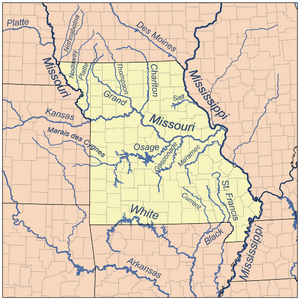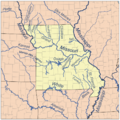Grand River (Missouri) facts for kids
Quick facts for kids Grand River |
|
|---|---|

Bluffs above the Grand at Adam-ondi-Ahman
|
|

Major Missouri rivers
|
|
| Country | US |
| State | Iowa, Missouri |
| Physical characteristics | |
| Main source | Creston, Iowa, US 41°01′30″N 94°16′05″W / 41.025°N 94.268°W |
| River mouth | Missouri River Brunswick, Missouri, US 620 ft (190 m) 39°23′02″N 93°06′29″W / 39.384°N 93.108°W |
The Grand River is a long river in the U.S.. It starts in Iowa near the towns of Creston and Winterset. The river flows for about 226 miles (364 km) (364 km) until it joins the Missouri River near Brunswick, Missouri.
The area of land that drains into the Grand River is called its watershed. This watershed covers about 7,900 square miles (20,000 km2) (20,460 km²). Most of this area, about three-quarters, is in Missouri. This makes it the largest watershed that feeds into the Missouri River in northern Missouri.
History of the Grand River Area
The Grand River area has a rich history. Many important events happened here long ago.
Early European Exploration
In 1723, a French explorer named Étienne de Veniard, Sieur de Bourgmont built a fort called Fort D'Orleans. People believe this fort was located where the Grand River meets the Missouri River. The French named the river "La Grande Riviére," which means "The Grand River." The fort was left in 1726 and later washed away by floods.
Native American Life
The land around the Grand River was once home to the Ioway Indian tribe. Their chief, Big Neck (also known as Great Walker), had his village on the Grand River from before 1824 until 1829.
The Big Neck War
In July 1829, Chief Big Neck and many Ioway people returned to their old hunting grounds. This was against a treaty they had signed. Some settlers felt threatened by their return. A group of settlers, led by Captain William Trammell, went to confront the Ioway.
The Ioway had moved upriver. Trammell's group followed them and a fight happened at a place called Battle Creek. Several Ioway people were killed, including Big Neck's brother and his family. Captain Trammell and two other settlers also died.
After the fight, the remaining settlers went south for safety. Later, a group of soldiers caught Chief Big Neck and his warriors in March 1830. They were put on trial. However, the jury decided they were not guilty, and they were set free. This helped bring peace to the area. Soon after, more settlers came back to live there permanently.
River Travel and Settlements
In 1835, the Missouri government said the Grand River was a "navigable stream" up to the Iowa border. This meant boats could travel on it. However, steamboats usually could not go much further than Chillicothe. The river's water levels changed a lot, making it hard for boats to travel far. The town of Bedford is even named after a steamboat that sank there.
Religious History
In 1837-38, Joseph Smith, who started the Latter Day Saint movement, said that Adam-ondi-Ahman was a special place. This site, near Gallatin, Missouri, was believed to be where Adam and Eve lived after leaving the Garden of Eden.
Geography of the Grand River
The Grand River is formed by several smaller rivers, called forks.
River Forks and Merging Points
The West Fork and East Fork of the Grand River start south of Creston in Union County, Iowa. The Middle Fork begins at Mount Ayr, Iowa in Ringgold County, Iowa. These three forks come together just south of Albany, Missouri in Gentry County. This is where the river officially becomes known as the Grand River.
Tributaries and Water Flow
The biggest joining of streams happens at Chillicothe. Here, the Thompson River and several creeks like Shoal, Medicine, and Locust creeks flow into the Grand River. The Grand River Basin has over 1,000 streams that are considered "third order" or higher, meaning they are part of a large network of waterways.
Swan Lake National Wildlife Refuge is a special place for wildlife. It is located on the Yellow Creek, which is a smaller stream that flows into the Grand River near Sumner, Missouri.
No Dams on the Grand River
There are no dams built on the Grand River. There have been ideas to build five dams at different times. The most well-known plan was for the Pattonsburg Dam at Pattonsburg, Missouri. The U.S. Corps of Engineers even bought land from people living there after the Great Flood of 1993. However, the dam was never approved or built.
River Discharge and Floods
The average amount of water flowing in the Grand River near Sumner, Missouri, is about 3,917 cubic feet per second (111 cubic meters per second). During a big flood in June 1947, the river's flow reached a huge 180,000 cubic feet per second (5,100 cubic meters per second). In the 1993 flood, the flow was reported as 150,000 cubic feet per second (4,200 cubic meters per second) at Sumner.
The Grand River generally drops about three feet for every mile it flows (0.5 meters per kilometer). However, one small branch called Pop's Branch, near Princeton, Missouri, drops much faster, about 44 feet per mile (8 meters per kilometer).
Images for kids
-
Bluffs above the Grand at Adam-ondi-Ahman



